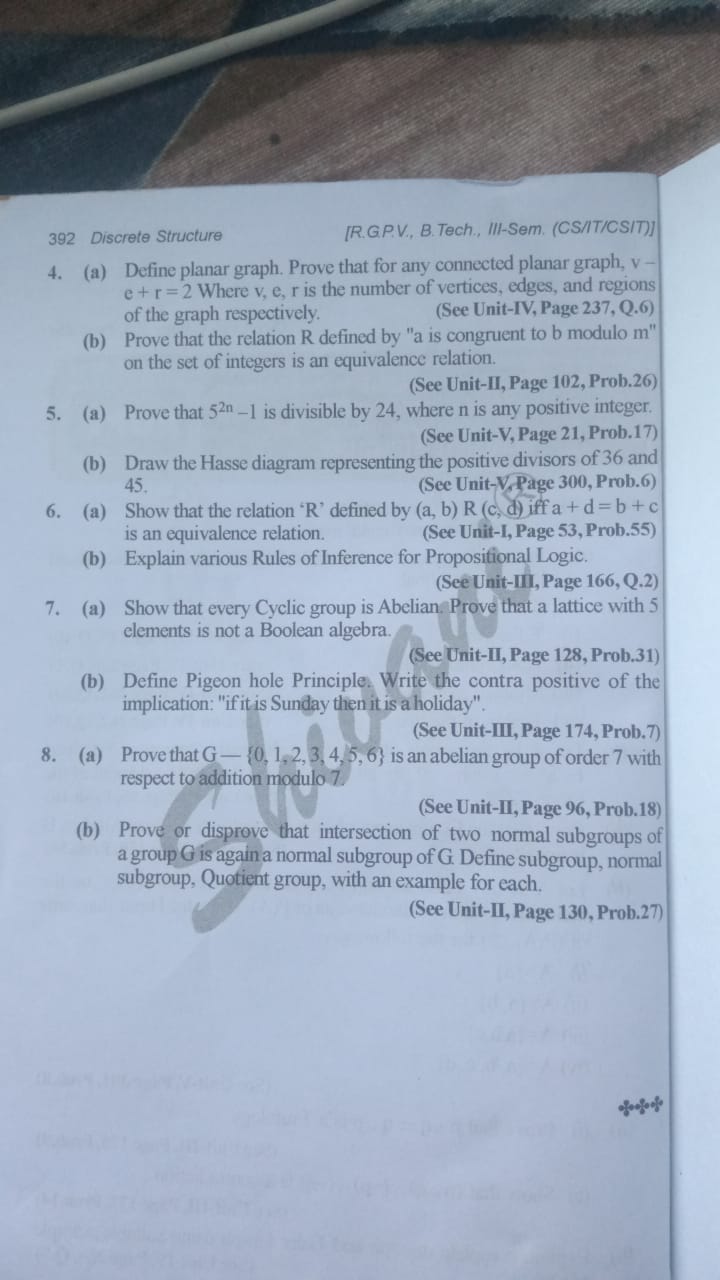Define planar graph. Prove that for any connected planar graph, v - e + r = 2 Where v, e, r is the number of vertices, edges, and regions of the graph respectively. Prove that 5^2n... Define planar graph. Prove that for any connected planar graph, v - e + r = 2 Where v, e, r is the number of vertices, edges, and regions of the graph respectively. Prove that 5^2n - 1 is divisible by 24. Draw the Hasse diagram representing the positive divisors of 36 and 45. Show that the relation R defined by (a, b) R (c, d) iff a + b = c + d is an equivalence relation. Explain various Rules of Inference for Propositional Logic. Show that every Cyclic group is Abelian. Prove that a lattice with 5 elements is not a Boolean algebra. Define Pigeon hole Principle. Write the contra positive of the implication: 'if it is Sunday then it is a holiday.' Prove that G = {0, 1, 2, 3, 4, 5, 6} is an abelian group of order 7 with respect to addition modulo 7. Prove or disprove that the intersection of two normal subgroups of a group G is again a normal subgroup of G. Define subgroup, normal subgroup, Quotient group, with an example for each.

Understand the Problem
The question contains various problems related to discrete structures, including definitions and proofs about graphs, equivalence relations, divisibility, and group theory. It seeks clear definitions and justifications for theoretical concepts in mathematics.
Answer
The planar graph is defined by \( V - E + R = 2 \), the relation \( R \) is an equivalence relation, and \( 5^{2n} - 1 \) is divisible by \( 24 \).
Answer for screen readers
- A planar graph is defined and proved using Euler's formula ( V - E + R = 2 ).
- The relation ( R ) defined by congruences is proven to be an equivalence relation.
- ( 5^{2n} - 1 ) is divisible by ( 24 ).
- Hasse diagram is constructed for positive divisors of ( 36 ) and ( 45 ).
- Rules of inference and their explanations are provided.
Steps to Solve
-
Define Planar Graph A planar graph is a graph that can be drawn on a plane without any edges crossing each other.
-
State Euler's Formula For any connected planar graph, Euler's formula states: $$ V - E + R = 2 $$ where ( V ) is the number of vertices, ( E ) is the number of edges, and ( R ) is the number of regions formed by the graph.
-
Prove Euler's Formula To prove this formula, we can use mathematical induction or perform a direct proof.
-
Base Case: For a simple graph with one vertex and no edges, ( V = 1 ), ( E = 0 ), ( R = 1 ) (the one region is the entire plane). Thus: $$ 1 - 0 + 1 = 2 $$
-
Inductive Step: Assume it's true for ( k ) edges. Adding a new edge can either increase ( E ) and ( R ) by one or connect two vertices already in the previous configuration without changing ( R ).
-
-
Define Equivalence Relation An equivalence relation on a set is a relation that is reflexive, symmetric, and transitive.
-
Prove the Relation ( R ) is Equivalence For the relation ( R ) defined as "a is congruent to b modulo m," prove:
- Reflexive: For any integer ( a ), ( a \equiv a \mod m ) (true because the remainder when ( a ) is divided by ( m ) is ( 0 )).
- Symmetric: If ( a \equiv b \mod m ), then ( b \equiv a \mod m ) (true as equality is symmetric).
- Transitive: If ( a \equiv b \mod m ) and ( b \equiv c \mod m ), then ( a \equiv c \mod m ) (true by properties of congruence).
-
Define ( 5^{2n} - 1 ) for Divisibility To prove ( 5^{2n} - 1 ) is divisible by ( 24 ):
- Note that ( 5^{2n} - 1 = (5^n - 1)(5^n + 1) ).
-
Divisibility by 3 Both ( 5^n - 1 ) and ( 5^n + 1 ) are consecutive integers; at least one is divisible by ( 3 ).
-
Divisibility by 8 For ( n \geq 1 ), observe ( 5^2 \equiv 1 \mod 8 ) implies ( 5^{2n} \equiv 1 \mod 8 ). Thus ( 5^{2n} - 1 \equiv 0 \mod 8 ).
-
Combine Results Since ( 5^{2n} - 1 ) is divisible by both ( 8 ) and ( 3 ): $$ \text{lcm}(8, 3) = 24 $$
-
Draw Hasse Diagram For the numbers ( 36 ) and ( 45 ) identify and represent their positive divisors using a Hasse diagram.
-
Show Rules of Inference Explain Modus Ponens, Modus Tollens, and others related to propositional logic.
- A planar graph is defined and proved using Euler's formula ( V - E + R = 2 ).
- The relation ( R ) defined by congruences is proven to be an equivalence relation.
- ( 5^{2n} - 1 ) is divisible by ( 24 ).
- Hasse diagram is constructed for positive divisors of ( 36 ) and ( 45 ).
- Rules of inference and their explanations are provided.
More Information
Euler's formula is a fundamental concept in graph theory, establishing a crucial relationship among vertices, edges, and regions for planar graphs. Understanding equivalence relations helps facilitate more complex algebraic structures in mathematics.
Tips
- Failing to verify all three properties of equivalence relations can lead to incorrect conclusions about a relation.
- Neglecting to check both divisibility conditions simultaneously might lead to incomplete proofs for divisibility problems.
AI-generated content may contain errors. Please verify critical information